+ Open data
Open data
- Basic information
Basic information
| Entry | Database: PDB / ID: 1hyk | |||||||||
|---|---|---|---|---|---|---|---|---|---|---|
| Title | AGOUTI-RELATED PROTEIN (87-132) (AC-AGRP(87-132)) | |||||||||
 Components Components | AGOUTI RELATED PROTEIN | |||||||||
 Keywords Keywords | SIGNALING PROTEIN / CYSTEINE RICH / DISULFIDE BOND / ICK / INHIBITOR CYSTINE KNOT / MELANOCORTIN ANTAGONISTS / AGOUTI / AGOUTI-RELATED / AGRP / ENDOGENOUS ANTAGONIST | |||||||||
| Function / homology |  Function and homology information Function and homology informationlong-day photoperiodism / type 1 melanocortin receptor binding / positive regulation of feeding behavior / regulation of feeding behavior / adult feeding behavior / neuropeptide hormone activity / feeding behavior / eating behavior / maternal process involved in female pregnancy / FOXO-mediated transcription of oxidative stress, metabolic and neuronal genes ...long-day photoperiodism / type 1 melanocortin receptor binding / positive regulation of feeding behavior / regulation of feeding behavior / adult feeding behavior / neuropeptide hormone activity / feeding behavior / eating behavior / maternal process involved in female pregnancy / FOXO-mediated transcription of oxidative stress, metabolic and neuronal genes / neuropeptide signaling pathway / hormone-mediated signaling pathway / circadian rhythm / response to insulin / Golgi lumen / signaling receptor binding / neuronal cell body / extracellular space Similarity search - Function | |||||||||
| Method | SOLUTION NMR / torsion angle dynamics | |||||||||
 Authors Authors | Bolin, K.A. / Anderson, D.J. / Trulson, J.A. / Thompson, D.A. / Wilken, J. / Kent, S.B.H. / Millhauser, G.L. | |||||||||
 Citation Citation |  Journal: FEBS Lett. / Year: 1999 Journal: FEBS Lett. / Year: 1999Title: NMR structure of a minimized human agouti related protein prepared by total chemical synthesis. Authors: Bolin, K.A. / Anderson, D.J. / Trulson, J.A. / Thompson, D.A. / Wilken, J. / Kent, S.B. / Gantz, I. / Millhauser, G.L. #1:  Journal: Mol.Endocrinol. / Year: 1999 Journal: Mol.Endocrinol. / Year: 1999Title: Characterization of Agouti-Related Protein Binding to Melanocortin Receptors. Authors: Yang, Y.K. / Thompson, D.A. / Dickinson, C.J. / Wilken, J. / Barsh, G.S. / Kent, S.B. / Gantz, I. #2:  Journal: Biochemistry / Year: 1998 Journal: Biochemistry / Year: 1998Title: Determination of Disulfide Structure in Agouti-Related Protein (Agrp) by Stepwise Reduction and Alkylation Authors: Bures, E.J. / Hui, J.O. / Young, Y. / Chow, D.T. / Katta, V. / Rohde, M.F. / Zeni, L. / Rosenfeld, R.D. / Stark, K.L. / Haniu, M. | |||||||||
| History |
|
- Structure visualization
Structure visualization
| Structure viewer | Molecule:  Molmil Molmil Jmol/JSmol Jmol/JSmol |
|---|
- Downloads & links
Downloads & links
- Download
Download
| PDBx/mmCIF format |  1hyk.cif.gz 1hyk.cif.gz | 534.1 KB | Display |  PDBx/mmCIF format PDBx/mmCIF format |
|---|---|---|---|---|
| PDB format |  pdb1hyk.ent.gz pdb1hyk.ent.gz | 444.7 KB | Display |  PDB format PDB format |
| PDBx/mmJSON format |  1hyk.json.gz 1hyk.json.gz | Tree view |  PDBx/mmJSON format PDBx/mmJSON format | |
| Others |  Other downloads Other downloads |
-Validation report
| Summary document |  1hyk_validation.pdf.gz 1hyk_validation.pdf.gz | 338.6 KB | Display |  wwPDB validaton report wwPDB validaton report |
|---|---|---|---|---|
| Full document |  1hyk_full_validation.pdf.gz 1hyk_full_validation.pdf.gz | 572.7 KB | Display | |
| Data in XML |  1hyk_validation.xml.gz 1hyk_validation.xml.gz | 27.4 KB | Display | |
| Data in CIF |  1hyk_validation.cif.gz 1hyk_validation.cif.gz | 46.7 KB | Display | |
| Arichive directory |  https://data.pdbj.org/pub/pdb/validation_reports/hy/1hyk https://data.pdbj.org/pub/pdb/validation_reports/hy/1hyk ftp://data.pdbj.org/pub/pdb/validation_reports/hy/1hyk ftp://data.pdbj.org/pub/pdb/validation_reports/hy/1hyk | HTTPS FTP |
-Related structure data
| Similar structure data |
|---|
- Links
Links
- Assembly
Assembly
| Deposited unit | 
| |||||||||
|---|---|---|---|---|---|---|---|---|---|---|
| 1 |
| |||||||||
| NMR ensembles |
|
- Components
Components
| #1: Protein/peptide | Mass: 5207.157 Da / Num. of mol.: 1 / Fragment: C-TERMINAL DOMAIN AC-AGRP(87-132) / Source method: obtained synthetically Details: This sequence is the native sequence for the cystine-rich C-terminal domain of the human agouti-related protein. The N-terminal acetylation at residue 87 (the first residue of the sequence) ...Details: This sequence is the native sequence for the cystine-rich C-terminal domain of the human agouti-related protein. The N-terminal acetylation at residue 87 (the first residue of the sequence) is non-native and done only to prevent a non-native positively charged amino terminus in the synthetic fragment. Synthesis was by means of standard BOC-based solid-phase peptide synthesis followed by refolding and oxidation of cysteines to cystines. References: UniProt: O00253 |
|---|---|
| Has protein modification | Y |
-Experimental details
-Experiment
| Experiment | Method: SOLUTION NMR | ||||||||||||||||
|---|---|---|---|---|---|---|---|---|---|---|---|---|---|---|---|---|---|
| NMR experiment |
| ||||||||||||||||
| NMR details | Text: STANDARD 2D HOMONUCLEAR TECHNIQUES WERE USED TO ASSIGN SPECTRA ACQUIRED OVER THE TEMPERATURE RANGE 288- 303 K. A SUBSET OF UNAMBIGUOUSLY ASSIGNED NOE PEAKS TAKEN FROM DATA ACQUIRED AT 288 K ...Text: STANDARD 2D HOMONUCLEAR TECHNIQUES WERE USED TO ASSIGN SPECTRA ACQUIRED OVER THE TEMPERATURE RANGE 288- 303 K. A SUBSET OF UNAMBIGUOUSLY ASSIGNED NOE PEAKS TAKEN FROM DATA ACQUIRED AT 288 K WITH AN 150 MS MIXING TIME WERE USED IN STRUCTURE CALCULATIONS, AS WERE 34 PHI BACKBONE ANGLE RESTRAINTS DERIVED FROM FITTING OF DQF- COSY CROSSPEAKS. BOTH CARRIER PRESATURATION AND Z- GRADIENT WET TECHNIQUES WERE USED FOR SOLVENT SUPPRESSION. New experiments from 1qu8 are E-COSY at 500 MHz and 150 msec 2D-NOESY at 800 MHz, 288K. |
- Sample preparation
Sample preparation
| Details | Contents: 1.9 MM Ac-AGRP(87-132) (same as 1.9 MM MARP of 1qu8) Solvent system: 50 MM PHOSPHATE BUFFER PH 5.0 (pH is changed from pH=4.2 in 1qu8) |
|---|---|
| Sample conditions | Ionic strength: 50mM PHOSPHATE / pH: 5 / Pressure: 1 atm / Temperature: 288.00 K |
| Crystal grow | *PLUS Method: other / Details: NMR |
-NMR measurement
| NMR spectrometer | Type: Varian UNITYPLUS / Manufacturer: Varian / Model: UNITYPLUS / Field strength: 800 MHz |
|---|
- Processing
Processing
| NMR software |
| ||||||||||||||||||||||||||||
|---|---|---|---|---|---|---|---|---|---|---|---|---|---|---|---|---|---|---|---|---|---|---|---|---|---|---|---|---|---|
| Refinement | Method: torsion angle dynamics / Software ordinal: 1 Details: The preliminary structure calculation and restraint quality assessment was performed in DYANA v 1.5, so that out of 200 structures the 20 with the lowest target functions would have target ...Details: The preliminary structure calculation and restraint quality assessment was performed in DYANA v 1.5, so that out of 200 structures the 20 with the lowest target functions would have target function vaules of < 3.0 square angstroms. The lowest target function structure of this family was then submitted as a pre-folded structure in CNS v. 1.0, and 40 structures calculated under cool (< 288K) simulated annealing and conjugate gradient energy minimization. These calculations were carried out in the presence of experimnetal NOE and J-coupling restraints as well as assigned hydrogen bonds consistent with HX protection. DYANA 1.5: 799 unique NOE's from 800 MHz data, 444 resulting distance restraints after pseudoatom calculation/replacement and removal of NOE's between atoms separated by only two or three bonds. 35 alpha-H to amide-H 3-bond J-coupling constants and 44 alpha-H to beta-H 3-bond J-coupling constants from ECOSY data were also included. Disulfides and seven hydrogen bonds as determinied from surrounding NOE's and HX data were included as pseudo-NOE restraints. CNS 1.0, patch level 0: 504 distance restraints from 800 MHz NOE data, corresponding to the same upper limit restraints as used in the final round of DYANA 1.5 calulations (conversion using AQUA 2.0 in PROCHECK_NMR, and modified lower limit of 1.6 angstroms was imposed on all NOE restraints while keeping upper bounds). Disulfide map was incorporated into the covalent structure of the molecule and thereby strictly enforced in this step. The seven hydrogen bonds were included in a separate restraint file. 34 alpha-H to amide-H 3-bond J-coupling constants (not including CYS-87 amide mesurement) were also included. 40 structures were so calculated and all are deposited here. | ||||||||||||||||||||||||||||
| NMR representative | Selection criteria: lowest energy | ||||||||||||||||||||||||||||
| NMR ensemble | Conformer selection criteria: see refinement method and details Conformers calculated total number: 40 / Conformers submitted total number: 40 |
 Movie
Movie Controller
Controller




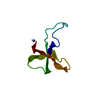
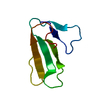
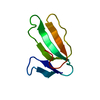
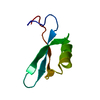
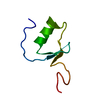
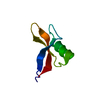

 PDBj
PDBj







